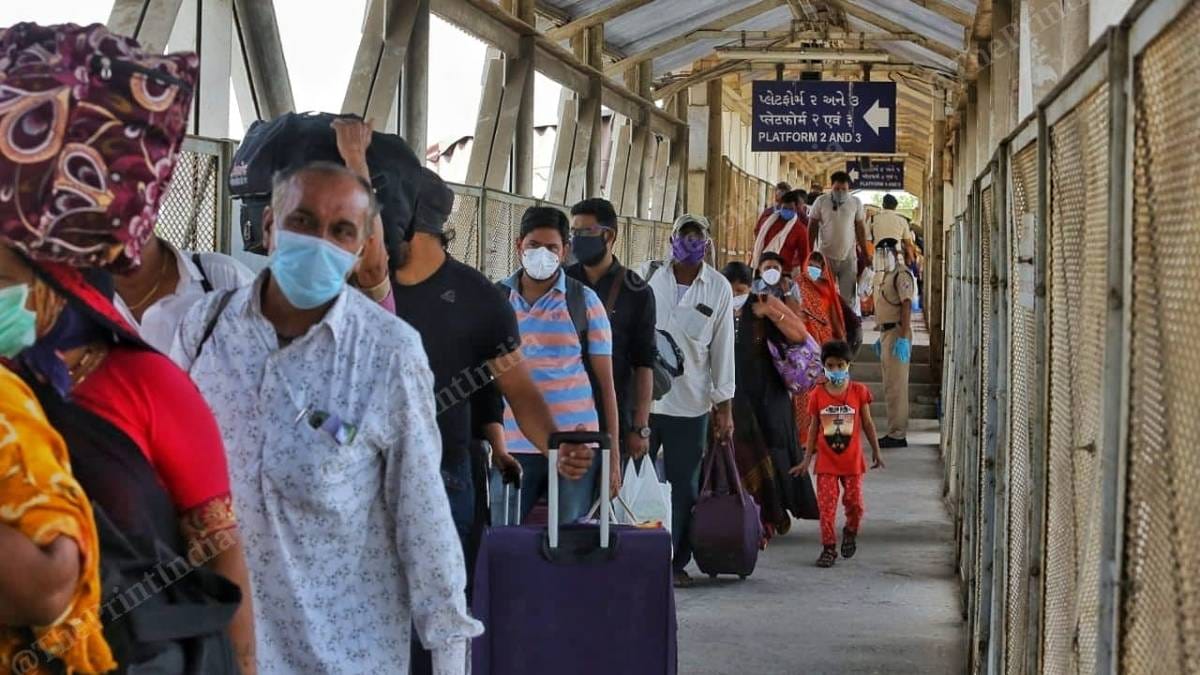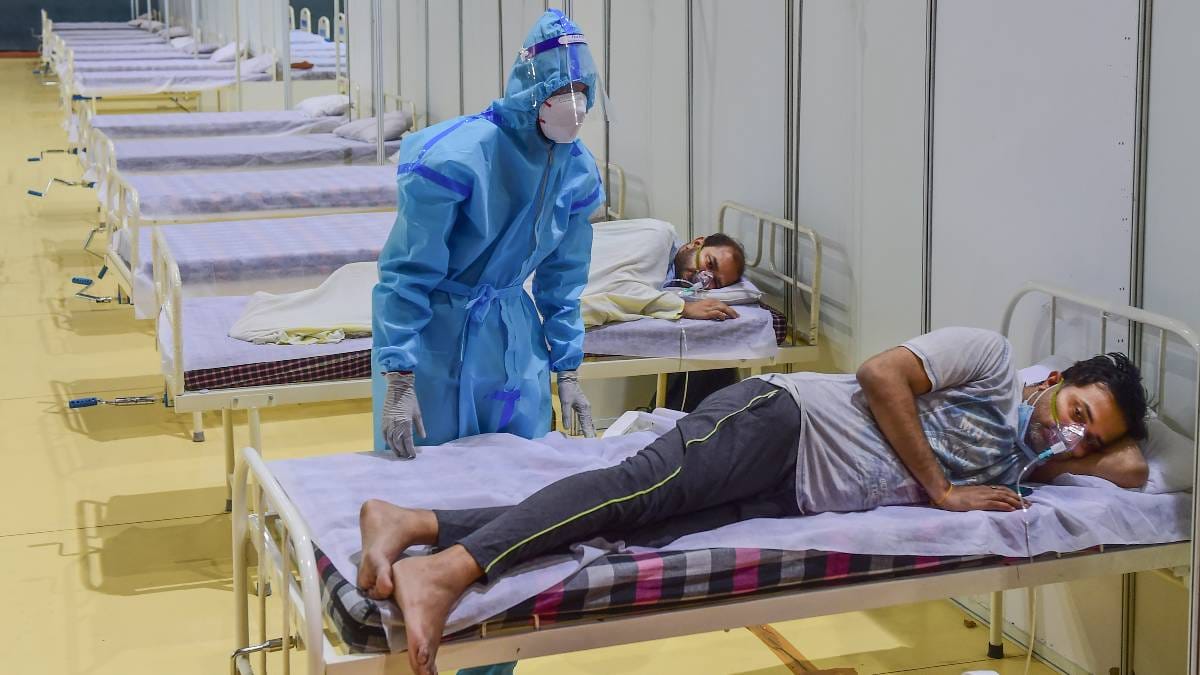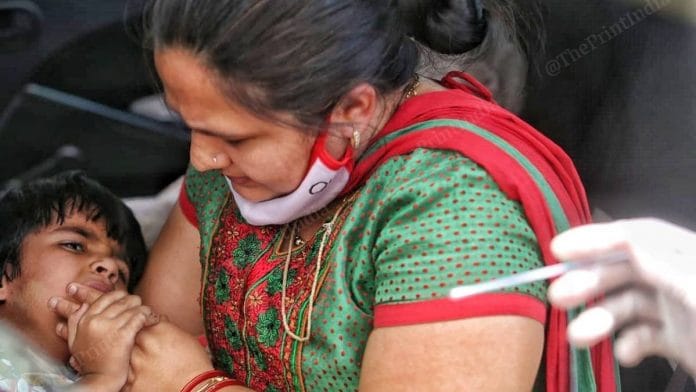Ahmedabad/New Delhi/Raipur/Dehradun: As the second wave of the Covid-19 pandemic rages, young people are now reporting severe lung infections and “unpredictable” symptoms, doctors across the country have told ThePrint. Young people had been relatively less affected by the pandemic during the first wave last year.
Many of them have been reporting ‘ground glass opacity’ in their lungs, which is a condition where the appearance of the lung changes because of the infection. The fact that several of the variants currently in circulation are more infectious, infecting entire families, could be one reason for the spike in cases in young people, suspect officials at the National centre for Disease Control.
Earlier this week, the Indian Council of Medical Research (ICMR) shared data that showed that a larger proportion of patients hospitalised with Covid during the second wave belong to the 0-19 years age group.
Experts say the possible explanation is that children were more protected last year since they were largely indoors. The gradual opening up over the last 10 months, culminating in the opening of schools and colleges in some parts of the country may have changed the age profile of patients in hospitals.
Also read: Past Covid infection doesn’t guarantee immunity even in young, vaccination must: Study in Lancet
Ahmedabad
Severe lung infections and unpredictable symptoms are the two main issues plaguing doctors in Gujarat. Dr Tarun Patel, who is part of the state Covid task force, told ThePrint, “More and more younger patients are turning up in the hospital with severe symptoms now. Children, who were previously asymptomatic carriers are now coming with severe symptoms.”
On how paediatricians were dealing with the situation, he said, “Most of the paediatricians have been caught off guard in this wave. They have no previous experience with treating children with severe Covid symptoms. Everybody is learning on the job now.”
Increased ground glass opacity and the sudden onset of pneumonitis (lung inflammation) are some of the problems that Covid patients in Ahmedabad are facing right now, according to doctors.
A senior doctor with the Civil Hospital in Ahmedabad told ThePrint, “We are witnessing what is known as Happy Hypoxia — the patient doesn’t know that their blood oxygen level is low and they will keep functioning normally. When the drop is too steep, they will simply drop, sometimes dead.”
Consultant physician Dr Manoj Vithlani also noted that Covid patients he attended showed a severe adverse response on the eighth or tenth day of hospitalisation, calling it a “worrying trend”.

However, a senior health official in the Ahmedabad Municipal Corporation denied any such trend. Speaking on the condition of anonymity, he said, “Compared to the number of cases, there are very few complications. We have a lot of ‘mild’ patients — about 60-70 per cent of the cases are mild and can do with home isolation. The problem that hospitals are facing is the shortage of oxygen supply and remdisivir [antiviral drug].
“The virus is not virulent, and only senior (citizen) patients with comorbidities are facing complications. And if a person is fully vaccinated, then the chances of complications are even smaller,” the official added.
Also read: More ‘deaths by illness’ in Ahmedabad than Covid as crematoriums see rise in ‘bimari’ funerals
Delhi
In the national capital too, the number of children and infants getting infected during the second wave has been on the rise. Several doctors ThePrint spoke to also claimed that many infants and newborns were testing positive for the infection, although their recovery rate was also higher.
In the 6-13 years age group, children who might have become carriers when accompanying their parents to hospitals, are believed to be responsible for other children getting infected, a doctor at LNJP hospital said.
According to Dr Chhavi Gupta, in-charge of Covid-19 at Rajiv Gandhi Super Speciality Hospital in Delhi, the number of children below 13 years of age being admitted to the hospital or seeking RT PCR testing has been higher than last year. When asked about specific data in this regard, she said: “We haven’t had a chance to maintain a separate list for children yet, but we can tell from the mere number of children we see around the Covid ward now.”
Vaccination is yet to be opened to children, though the government will begin vaccinating those who are 18 years and above starting 1 May.
Dr N.N. Mathur of Lady Hardinge Medical College, another key Covid hospital in the national capital, noted that while adolescents weren’t quite infected during the first wave (if at all, “these were asymptomatic cases”), children now are coming with symptoms, and some are even severe cases.
Diarrhoea, vomiting, high fever and cold are among the common symptoms seen in children with Covid.

Dr Arvind Garg, senior consultant child specialist and neonatologist at Apollo Hospital, Noida, said they are not seeing any serious cases of Covid in children, though the number of cases itself is “definitely much more”.
“We shouldn’t panic as these are usually behaving like routine viral illnesses, but parents need to take precautions if not for themselves, then at least for their young ones,” he said.
Meanwhile, several cases among younger children (5-12 years) emerged when schools and educational institutes reopened.
A total of 1,307 children between 5-12 years were surveyed in the fifth round of the serological survey in Delhi, of which nearly 50 per cent were found to have antibodies, a senior researcher of Maulana Azad Medical College involved in the survey told ThePrint. The survey was conducted between 15 and 23 January this year, when daily new cases were averaging about 300 cases.
Also read: Centre increases oxygen supply to Delhi, but hospitals have only hours left till they run out
Chhattisgarh
In Chhattisgarh, as in other parts of the country, symptoms have differed in comparison to last year.
“Last year, people would get discharged in eight days. But now symptoms are surfacing on the eighth day. Last time, the symptoms were only fever, cough, cold and breathing difficulties but now, along with all this, there is a dip in oxygen levels, high fever is persisting and we are seeing blood clots, cardiac arrest, brain haemorrhage as well,” Chief Minister Bhupesh Baghel told ThePrint.
“While on 1 March, only a few dozen people required oxygen support, now that number has risen to 6,000,” he added.
Both the CM as well as Health Minister T.S. Singh Deo said that a higher proportion of younger people are getting infected this time around. “Mortality rate among those below 45 years is 25 per cent now,” Deo told ThePrint.
Also read: This Chhattisgarh village had no Covid case until 5 April, religious meet changed that to 100
Uttarakhand
In Uttarakhand’s capital, 4,807 cases were reported Wednesday. The state so far recorded 1,34,012 cases.
“It’s spreading very fast, and whole families are being affected. Schools have also played a role in spreading the infection among children, although their symptoms tend to be mild and manageable,” said Dr L.K. Chowdhary, who manages over 100 Covid-19 patients a day in Synergy Hospital, Dehradun.
Three doctors ThePrint spoke to, including Chowdhary, said the disease pattern was more severe this time around, compared to last year when initial symptoms presented were milder.
“Earlier, people would come with a loss of smell and taste, but now the more prevalent symptoms that first surface are fever and cough. In my experience, the percentage of people presenting with a fever has increased,” said Dr Siddhant Khanna, a general physician who treats Covid-19 patients in both public and private set-ups.
Agreeing, Dr Chowdhary said, “People are straight away coming with a more advanced stage of illness, and beds are being occupied by younger people too this time.”
The second wave has also brought with it unique symptoms which were less prevalent than before, said Dr Anurag Agarwal, head of Department for Respiratory Diseases in Doon Hospital, the main Covid hospital in the state.
“RT-PCR results are showing more false negatives this time. A few patients are also presenting the symptom of coughing with blood, in which case we cannot give blood thinners,” he told ThePrint.
“Some other unusual symptoms are dizziness, severe headache, vomiting, diarrhoea, and skin rashes. It seems that mortality hasn’t been affected, but there are complications in moderate to severe patients,” he added.
(Edited by Manasa Mohan)
Also read: ‘Highly infectious’ double mutant strain was circulating in Uttarakhand even before Kumbh began







Authors at theprint never ceases to amaze.
Till now it was spinning negative news pictures demagoguery darkness through kumbh.
Here comes a gem from a gem who is celebrating wuhan virus infections as some kind of shab a baraat or mohram.
Wuhan virus has betrayed the best in human depravity and callousness from theprint fraternity and it’s other media warriors swatis jyotis, serwanis, joshis guptas, rubbishs, dutts, roys the list is just endless.
On this occasion let’s just celebrate.